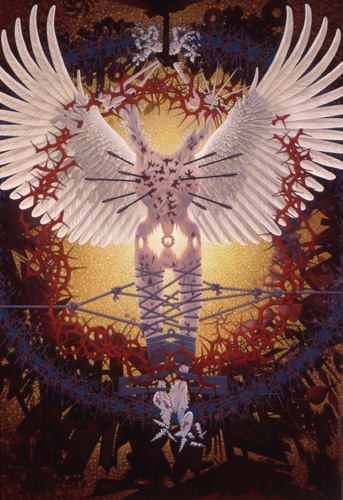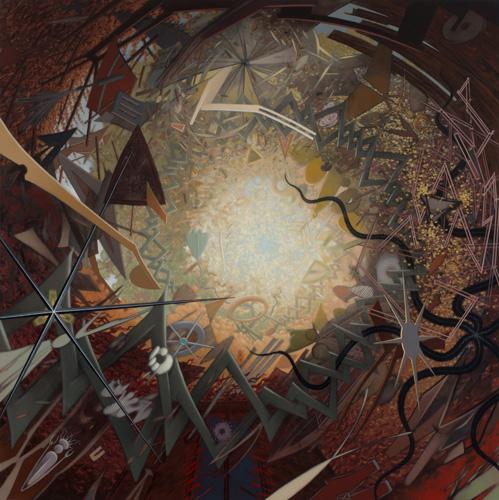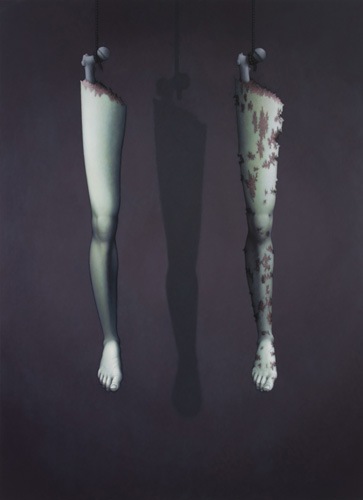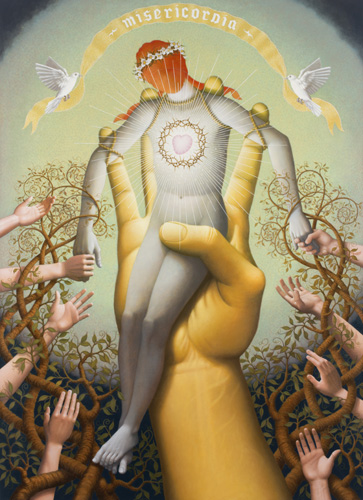
1987, acrylic on canvas, 96 x 66 in.
Courtesy of Jim Starrett and Pat Styles, Venice, California
| Paintings | Home | Works on Paper |
| Painting Slideshow | High Resolution Images | Works on Paper Slideshow |
| Side Projects | Artist Talk Videos | Monthly Highlights |
| Statements | Published References | Exhibitions |
The Arc of Transcendence: The Paintings of Brian Mainsby Gordon Fuglie |
 1987, acrylic on canvas, 96 x 66 in. Courtesy of Jim Starrett and Pat Styles, Venice, California |
"Is he kidding?" So asked a colleague as he stood before an eight-foot-high canvas by Brian Mains depicting a winged human corpse on the cusp of radiant transcendence [see Plate 6]. As the brand new director of Loyola Marymount University's Laband Art Gallery, I cringed. I had hoped that the first exhibition I organized at the university would be greeted with affirmation. |
But this was 1989, at the end of a decade that saw the world of contemporary art awash with theory and de rigueur irony, an era that embraced the hermeneutic of skepticism. Master narratives (especially those imbued with spirituality), historical meaning, artistic beauty, and the autonomy of the author and artist were seen as constructs in the service of ruling elites. My colleague, a professor of design in the department of art and art history, had spent the last few months reading Jacques Derrida and had become inflamed with the deconstructionist enterprise. Every text and image was ripe for picking apart for its "ambiguities" and "contradictions," until, disassembled, literary and artistic meaning collapsed under an assault of criticality. |
To be sure, Brian Mains isn't kidding, and he could care less about the rising and falling trends of the contemporary art world. Since the mid-1970s he has been in earnest—as a painter grappling with the challenge of depicting the transitory and transformational nature of reality and incorporating spiritual, religious, and philosophical themes into his iconic, magical, and theatrical canvases. His earliest mature work was abstract, using graphic forms to represent states of incompleteness, movement, disintegration, and destruction— culminating in transcendence. Surprisingly, this early work eschews the expressive brushstroke so often associated with abstract painting. The paintings are limned with deliberate precision, evidence of the artist's commitment to fabricate a metaphysical place or moment where change and transformation are alarmingly palpable. |
 1978, acrylic on canvas, 84 x 74 in. Collection of Gary Kubena, Houston |
Such a work is an untitled acrylic (his preferred medium) from 1978 [see Plate 7]. The palette is largely muted, using soft turquoises, buff, sienna, and brick tones, and shades of white and gray. In the foreground Mains suggests vertiginous movement with patterns of sharp black and deep gray lines that suggest a phalanx of bristles, whizzing sheet-metal-like strips, spiky flora, and other salient semi-organic forms. The area at left is inchoate; a tenebrous gray almost obscures a variety of indeterminate mobile shapes. Here and there are glimpsed elements of a transcendent realm, sections of luminosity that represent what Mains has called the "blue portal of heaven" that frequently exists behind the dizzying flux of his compositions. The overall effect of this and other works from the evolving series is a careening chaos barely contained within a larger cosmic order. If this painting had a soundtrack, it would be composed by Edgar Varèse, the French avant-gardist whose music is full of arcs of rising and falling sound punctuated by staccato bursts of percussion. |
Through the seventies and into the eighties, Mains produced work that seemed to parallel new trends in the contemporary art world, among them the so-called "return of painting" and the reintroduction of recognizable objects and figuration. One such trend was the New Imagist painting from the East Coast, characterized by coarsely fashioned, large-scale monochrome or limited-palette canvases featuring a few recognizable objects, animals, or human figures. Perhaps out of anxiety about displaying any technical mastery—which would have suggested an interest in the great traditions of painting, then a taboo association—New Imagists like Philip Guston (considered a pioneer of the movement), Neil Jenney, Robert Colescott, Nicolas Africano, Jennifer Bartlett, and Susan Rothenberg cultivated the look of crudity and ineptitude. The awkwardness of their images combined with a studied indifference to painterly facility was just provocative enough to make the art world wonder whether this marked a change in the aesthetic climate after years of purist abstraction or the arid intellectualism of conceptual art. |
By contrast, Mains's paintings from this period seem more genuinely provocative. Rather than taking a reductive, tossed-off approach to representational imagery, he envisioned convincing metaphysical realms that claim the viewer's attention with their swirling, whirling chaos. In this respect, Mains's work is independent from that of the New Imagists. Seen at a distance, his paintings from the late seventies and early eighties have the look of gestural abstraction, a mode of spontaneous painting produced by impulsive paint application. Its advocates claimed that this method took art to its primal (read: authentic) origins. Mains's environments, however, only appear to be made spontaneously. Once they are drawn in charcoal upon the canvas, he carefully selects his color scheme and labors over them for months; in recent years he has been able to produce only one large painting per year. |
The eighties were especially fruitful for Mains, though he often worked and exhibited beneath the radar of art critics and gallerists. In New York, neo-expressionism became the next big thing with its large scale and—mirabile dictu—audacious assertion of figuration and narrative, notable in the work of Julian Schnabel, Eric Fischl [see Image issue 39], Robert Longo, David Salle, and Jim Morphesis [see Image issue 5]. Salle was one of its more controversial artists; he believed that the domination of the formalist aesthetic of pure perception in abstract painting and sculpture was coming apart. "People seem to want to look at pictures of things again," he said in an interview in Flash Art. And, increasingly, painters seemed to want to paint pictures that included them. In 1985, Mains produced two seminal works depicting things, but things not of this world: Dark Vortex and its companion, Light Vortex, took his art in a new direction. |
 1985, acrylic on canvas, 66 x 66 in. Courtesy of Hunsaker/Schlesinger Fine Art |
Dark Vortex [see Plate 8] marked an interest in more deliberate and balanced composition. The outer whorl of dusky forms that churn in jagged double helixes, spinning blades, dagger-pointed stars, and prehistoric sea-life is enveloped by a crimson vegetable mass. For Mains this chaos represents death and loss. But as these turbulent forms recede, they gently disintegrate into (or are consumed by) a glowing turquoise light (the artist's blue portal of transcendence) at the center of the painting. Mains, who has no formal religious affiliation, identifies this light as "heavenly existence," and in 1985 Dark Vortex was his clearest statement of transcendence to date. Readers of the Gospel of John may associate this image with its prologue: "What has come into being in him [the cosmic Christ] was life, life that was the light of men; and light shines in the darkness; and darkness could not overpower it." |
Light as transcendence has been a conceptual motif in Mains's paintings for virtually his entire career, and it became more central to his compositions in the mid-1980s. He describes his work as a steady metamorphosis, where ideas and images are developed over a series of paintings. According to the artist, the eventual decision to include the human body in his work became "the logical choice...because the figure was just the vehicle I needed for conveying life's changes. I realized that life affects us in our bodies, and our bodies are the basic conveyors of meaning for us in the world." |
Mains's first use of the human form was Winged Figure, the painting that so vexed my deconstructionist colleague. In this work he created a tightly symmetrical composition, placing a decaying corpse in the center, a figure trussed by the wrists, suspended by taut ropes around the thighs, and clamped in irons about the lower legs. Coincidentally, Mains admires the work of the northern Renaissance painter Matthias Grünewald, and his figure's arrow-pierced torso recalls numerous German and Flemish images of suffering saints like Sebastian. Encircling the figure is a ruddy crown of thorns, an allusion to Christ's Passion and death. Beyond it, a ring of murky, chaotic shapes is held in suspension as the figure takes glorious wing into the heavenly realm where death and decay are overcome. Mains takes inspiration from significant and profound themes in art history and literature, expanding their meaning by reinterpreting them in his paintings. |
Winged Figure and Mains's other uses of deteriorating, entangled, and stressed human forms have a parallel in the expressive figures of Leonard Baskin, a sculptor, printmaker, and typographer who produced single monumental figures noted for their arterial and veined constructions, physical distortions, and partial shapes. Baskin, the son of an Orthodox Jewish rabbi, reached artistic maturity in the 1950s, and his concerns were typical of a number of artists who emerged in the wake of World War II. His work depicted a vulnerable, isolated, and very mortal humanity dwelling in a landscape haunted by the Holocaust and menaced by nuclear warfare. Despite Baskin's dark outlook, like Mains a generation later, he could yet see the body in transcendent terms; he observed, "Our human frame, our gutted mansion, our enveloping sack of beef and ash is yet a glory. I still hold the cracked mirror up to man." |
Although both Mains and Baskin give primacy to the figure, their enterprise was not informed by a desire to restore or elevate figuration as a norm in contemporary art, as was the aim of some conservatives in the new figurative academies that sprung up in the 1980s. Rather, their treatment of the figure is first of all existential, and corresponds to remarks made nearly fifty years ago by Paul Tillich, the liberal Christian theologian and astute observer of contemporary art who was a contributor to the catalog of the landmark but underappreciated exhibition New Images of Man at the Museum of Modern Art in 1959: "These images take the human situation, indeed the human predicament, rather than the formal structure [of the figure] as their starting point. Existence...is of the greatest concern to them." In addition to Baskin, Tillich had in mind the work of the British painter Francis Bacon, French painter and sculptor Jean Dubuffet, Swiss painter and sculptor Alberto Giacometti, Italian sculptor Marino Marini, and the American painter Leon Golub. |
The existential parallels between Mains and the previous generation of figurative artists are marked, however, by a significant difference: the overt incorporation in Mains's work of metaphysical, philosophical, and religious ideas and related imagery. By contrast, the despairing, isolated, and scabrous figures of Baskin, Bacon, Giacometti, and Golub are the expressions of a post-religious modernist culture in the wake of World War II. Mains, who started producing serious work in the late seventies, is a child of postmodernism, a period that has opened up possibilities for artists that mid-twentieth-century modernism in its historical despair and drive for aesthetic purity eschewed. With its view of human isolation and the loss of transcendence, modernism could not comprehend art with deliberately spiritual content. If the postwar generation presented difficult images of an alienated humanity, Mains, in his exploration of the spiritual aspects of existence, delivered images no less challenging in their encompassing of destruction, death, and transformation (a form of hope for the artist) in a single painting—and a technically polished one in the bargain. |
 1994, acrylic on canvas, 66 x 66 in. Collection of Nora Eccles Harrison Museum of Art, Utah State University |
In Wheel of Life from 1994, Mains employed multiple figures in his composition, a reworking of the Buddhist concept of the Wheel of Existence [see Plate 9]. Elementally, Buddhism sees the world as a delusion and therefore a snare, entrapping humanity in an endless round of striving that holds participants in its grip. To break the cycle and obtain release, Buddhism advocates meditation, good works, and nonattachment to the world. With intricacy and elegance, Wheel of Life imagines this condition at the moment when an intertwined and entangled humanity loosens its grip to reach for enlightenment, symbolized by the purifying flames of the central aureole. The serpentine band of white cloth binding the ring of figures not only serves as a compositional device, it also conveys the blindness inherent in lives caught up in perpetual striving and, in the wrapping of each head, lends the figures a sense of commonality in their plight and potential for liberation. |
A number of viewers of Mains's paintings have commented on what they perceive as an illustrational sensibility, though the artist will retort that "the work is the content, not illustrative of it." Most likely these viewers are responding to the pronounced graphic quality that gives the paintings and drawings visual punch and clarity, a characteristic that was developed during Mains's abstract period of the seventies and eighties. Moreover, he notes that his imagery and figuration are not about the traditional approach to the human form where anatomically accurate beings drawn from models in controlled studio conditions are placed within a narrative setting—historical, mythic, religious, or quotidian. Neither are his figures a nod to the artistic legacy of physical ideals or the body as the apex of beauty in western culture. Rather, Mains's figures are stylized and occasionally mannered renderings that are adapted to fit the overall concept and design of his composition. |
 1996, acrylic on canvas, 66 x 48 in. Collection of Gaby Stuart, Los Angeles |
Trinity from 1996 is such a work [see back cover]. It delivers a startling bodily presence that stands more traditional figurative concepts on their heads. Against a burgundy field glowing with a sacral melancholy (Mains refers to this field as a "magical space") hang two severed legs, suspended from their hip joints. Between them is a mysterious single shadow that seems cast by and related to both limbs. Trinity is a unique image in the tradition of Christian-themed art, which has either depicted the triune concept of God with abstract iconographic symbols or in anthropomorphic terms—a white-robed and bearded older man (God the Father) in the vicinity of Jesus (God the Son) with the Holy Spirit as a white dove hovering near by. Mains's stark reductivist version of the Trinity incorporates his earlier understanding of the cycle of death, decay, and transcendence with the Christian concept of God as three persons in one divine entity. The artist associates the pure form of the left leg with the Father, the ravaged leg with the suffering Son, and the unified shadow of the two legs with the Holy Ghost. As a result, what first appears as a horrific display of amputations becomes, upon contemplation, a merging of fragments that combine to imbue the human with the transcendent in a darkly compelling vision. One critic described Mains's Trinity as "grim, weird, and completely unforgettable." |
Contemporary art during the eighties and nineties tended to represent the body as a physiological thing, a fragment or series of parts rather than an existential being. Perhaps this was because many contemporary artists felt that the whole body had become a cliché or lacked the mystery, the emphatic wallop, of a fragmentary corpus or a single limb juxtaposed with other formal elements. On the other hand, the partial body calls to mind some five hundred years of western admiration for "tragically" ruined classical sculpture. The winged but armless and headless Victory of Samothrace and the surging muscular vitality in Apollonius's dismembered Belvedere Torso cause us to speculate about what they might once have been; we know that they spoke to the ancient Greek quest to come bodily to terms with the vagaries of human existence and the elusive purposes of the gods. |
In contrast, consider the American artist Jasper Johns, who began to use body fragments (hands, arms, ears, noses, penises) in his assemblage paintings in the 1950s. With Johns there is never a question of a part implying or leading to a complete human form, much less a reckoning with existential concerns. His deconstruction of the body reduced it to a poetic conceit, or worse, an indifferent motif. Indeed, Johns's use of body parts is indistinguishable from his repertoire of other objects like numbers, targets, flags, and ale cans. Throughout his fragmented and objectifying compositions that employ the figure, he has succeeded in draining it of vitality. |
As Mains has shown, however, bodily fragmentation need not mean the loss of the human or the objectification of the body. He is among a number of boomer-generation artists in Southern California like Enrique Martínez Celaya, Tanja Rector, and John Frame [see Image issue 41] whose works incorporate limbs and partial or obscured bodies, but invest them with a conviction about their humanity, resulting in a restoration of the body's power to invite the viewer's empathy. |
Empathy is what Michael Duncan, the Los Angeles critic and corresponding editor for Art in America, found lacking in too much late twentieth-century Southern California art. As the influence of the region's three theory-driven power art schools—California Institute of the Arts, Art Center College of Design, and UCLA's MFA graduate program—became near hegemonic over a new generation of emerging artists during the 1990s, Duncan was troubled to discern that the dominant tendency was an aesthetic of affected cool. The academic embrace of distancing strategies convinced him that local contemporary art had dug itself into a hole and was losing its audience. Duncan blasted the cool stance for its easy irony, lack of commitment, slacker ineptitude, and academic party-line conformity, declaring a moratorium on theory-clotted shows addressing impenetrable notions like "entropic dystopia," "apocalyptic simulacra," and "post-gender anomie." He instead sought out artists whose work was "personally revelatory, confessional, or content-driven." A man with a mission, in 2001 Duncan assembled an exhibition whose declared purpose was nothing less than the reanimation of "the moribund soul of contemporary art." Entitled The Importance of Being Earnest, it opened at Occidental College, a small liberal arts school tucked in the foothills north of downtown Los Angeles. The response to Duncan's shot across the bow of the academic art world was favorable and led to a larger successor exhibition, LA Post-Cool, for the San Jose Museum of Art and the Ben Maltz Gallery at Otis College of Art and Design in 2003. |
For both shows Duncan selected large, dramatic canvases by Mains. He also included work by the Catholic painters Laura Lasworth and Patty Wickman, with whom Mains is sometimes compared [see Image issues 17 and 25]. In the same year as LA Post-Cool, Mains had his first local one-man exhibition in twelve years when Hunsaker/Schlesinger Fine Art decided to include him in their stable. The centerpiece of this commercial exhibition was Misericordia [see Plate 10], his most Christian image to date. |
 2001, acrylic on canvas, 66 x 48 in. Courtesy of Hunsaker/Schlesinger Fine Art |
The composition of Misericordia derives from numerous Renaissance images of God the Father holding a dead Christ. To universalize the dead figure, Mains rendered it featureless. The historical tradition of Christian iconography and theology also encourages the interpretation of Jesus as one of us; the dead figure unites our fate with Christ's. Instead of an old, white-bearded man, God is here portrayed as a large golden hand that, according to Mains, carries "the Body of Man to heaven as the hands of earthly beings reach out to comfort the dead." It is a tender, merciful image, as its title banner declares. As the body is lifted, the branches of worldly entanglement release their hold. The soul appears as a glowing radiant heart framed by a crown of thorns, symbol of Jesus's Passion, and for the artist, of painful entanglement transcended. |
For much of the contemporary art world, Mains's Christian/Buddhist paintings with their iconic compositions and ravaged figures are still too hard to take—not exactly the solution to the large wall in your entryway or a candidate to hang over the couch (they're too big, anyway). It is one thing for contemporary art to be challenging in the way we have come to expect, but quite another for it to turn us inside out and propel us on a trajectory from a hellish earth to the radiant heavens. Mains sold only two works from his 2003 solo show, the painting Trinity and a drawing, both to an independent-minded and eclectic collector from West Hollywood whose house is chockablock with art of all kinds. Such abodes are perhaps the most hospitable homes for work like his—already containing multitudes, they are environments primed to host work that offers the maximum. Or as critic Michael Duncan sees it, Mains's paintings unearth "the profound disquiet that lies beneath our culture's rampant superficiality." |
|
Reprinted courtesy of Gordon Fuglie and IMAGE: Art· Faith· Mystery. |